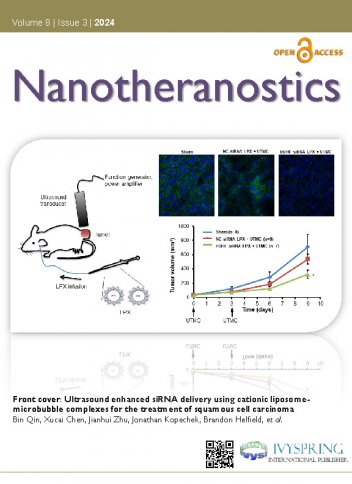ISSN: 2206-7418Nanotheranostics

Nanotheranostics, the sister journal of Theranostics, is a multidisciplinary and fully open access journal. Nanotheranostics publishes innovative and original basic, translational and clinical research reflecting the fields of nanomedicine, nanoimaging, drug and gene delivery, nanoelectronic biosensors, and related areas.
Regular features include high quality research articles, reviews or mini-reviews, rapid communication of preliminary data on innovative research, editorials, and letters to the editor. Educational articles on basic sciences, fundamental aspects and controversy related to pre-clinical and clinical studies or ethical issues of nanomedicine are also welcome. Timely reviews that provide updates on current applications and issues in nanomedicine and translational aspects of nanotheranostics and other topics are particularly welcome and will be given high priority.
Nanotheranostics employs a rigorous peer-review system, but also strives for rapid review turnaround times and is based on the same streamlined submission platform as Theranostics.
Recent Papers:

Research Paper
Unraveling In vivo Potential of Curcumin-loaded Graphene Quantum Dots on Drug Delivery and Release Kinetics Aspects of Cancer Treatment
Mochamad Z. Fahmi, Siti F. A. Sugito, Aswandi Wibrianto, Siska Novania, Shinta Widyastuti, Musbahu Adam Ahmad, Satya C. W. Sakti, Lee H. Voon
Nanotheranostics 2024; 8(4): 521-534. doi:10.7150/ntno.96559
Full text
PDF

Review
Therapeutic and Contrast Agents for Photoacoustic Imaging-Guided Photothermal Therapy: A Narrative Review
Donni Kis Apriyanto, Mitrayana, Andreas Setiawan, Rini Widyaningrum
Nanotheranostics 2024; 8(4): 506-520. doi:10.7150/ntno.96286
Full text
PDF
PubMed
PMC

Research Paper
Neuroprotective Effects of Zinc Oxide Nanoparticles in a Rotenone-Induced Mouse Model of Parkinson's Disease
Yasmeen Khafajah, Mariam Shaheen, Dania El Natour, Maxime Merheb, Rachel Matar, Jamilah Borjac
Nanotheranostics 2024; 8(4): 497-505. doi:10.7150/ntno.95863
Full text
PDF
PubMed
PMC

Review
Nanomedicine And Nanotheranostics: Special Focus on Imaging of Anticancer Drugs Induced Cardiac Toxicity
Aseem Setia, Randheer Reddy Challa, Bhaskar Vallamkonda, Phanikumarreddy Satti, Abhishesh Kumar Mehata, Vishnu Priya, Senthil Kumar, Madaswamy S. Muthu
Nanotheranostics 2024; 8(4): 473-496. doi:10.7150/ntno.96846
Full text
PDF
PubMed
PMC

Review
Peptide Conjugated Boron Neutron Capture Therapy for Enhanced Tumor Targeting
Vaskuri G.S. Sainaga Jyothi, Nagavendra Kommineni
Nanotheranostics 2024; 8(4): 458-472. doi:10.7150/ntno.95251
Full text
PDF
PubMed
PMC

Research Paper
Dual Functional Magnetic Nanoparticles Conjugated with Carbon Quantum Dots for Hyperthermia and Photodynamic Therapy for Cancer
Mounika Choppadandi, Kondi Soumya, Sumanta Ghosh, Aishwarya Balu, Tanvi Shingote, Srivalliputtur Sarath Babu, Vani Sai Prasanna, Somasundaram Arumugam, Ravichandiran Velyutham, Murali M. Yallapu, Govinda Kapusetti
Nanotheranostics 2024; 8(4): 442-457. doi:10.7150/ntno.91871
Full text
PDF
PubMed
PMC
Editor-in-Chief:
Jonathan F. Lovell
SUNY Empire Innovation Professor
Department of Biomedical Engineering
University at Buffalo, State University of New York
Nanotheranostics has been selected by The Literature Selection Technical Review Committee (LSTRC) for inclusion in MEDLINE, the prestigious index of U.S. National Library of Medicine.
Nanotheranostics is now indexed in the Web of Science, Biological Abstracts and BIOSIS Previews.
- Full texts of articles in PubMed Central and Europe PMC. Abstracts in PubMed.
- (For NIH-funded researchers) Save time by submitting your paper to us - this journal is in full compliance with NIH Public Access Requirement.
Impact Score is 4.83, and h-Index is 25 based on information from Resurchify, 2023
Special Issue: Nanocontrast for Molecular Imaging of Cancer. Guest Editors: Dr. Rajendra Prasad, Prof. João Conde, Prof. Amnon Bar-Shir, Dr. Narendra Gupta, Dr. Nagavendra Kommineni
Special Issue: Exploring the Frontier of Healthcare: Bioinspired and Biomimetic Nanotheranostics. Guest Editors: Drs. Murali M. Yallapu, Ajeet Kaushik, Kaushal Rege, Arpan Pradhan, Anuradha Kumari, Narendra Gupta.
Special Issue: Translational Nanomedicine and Biosensors. Guest Editors: Drs. Shweta Meena, Asifkhan Shanavas, Arvind K Rengan, Shabir Hassan, Berney Peng, Avtar Singh, Arnab Ghosh, Sunita.

 Global reach, higher impact
Global reach, higher impact